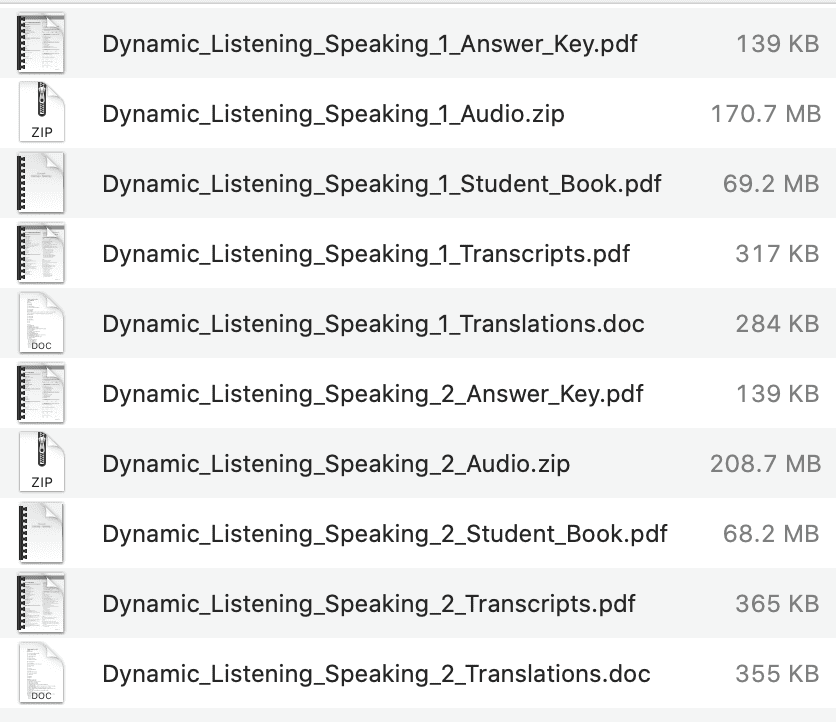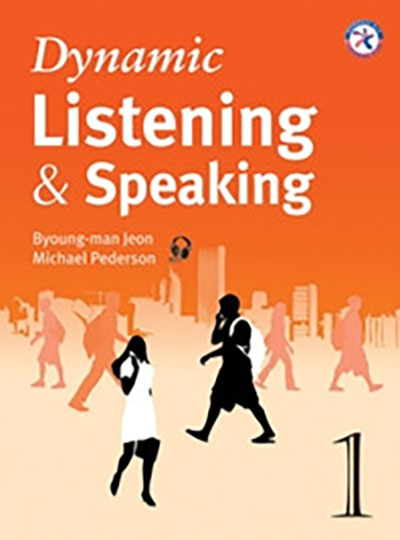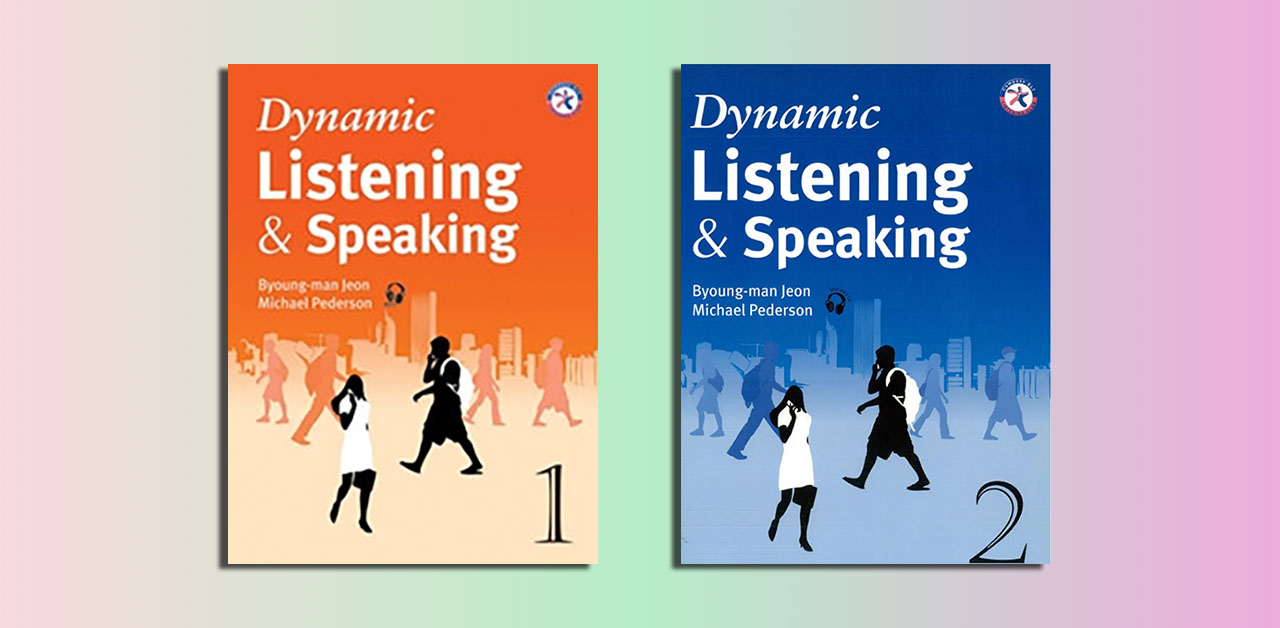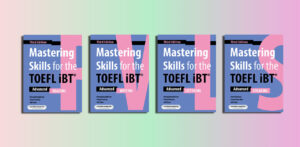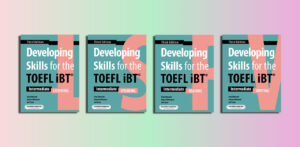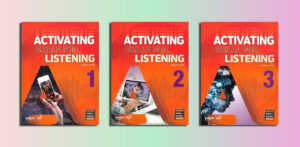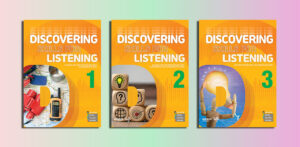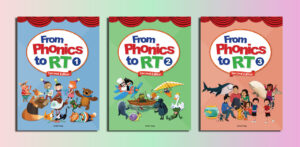Dynamic Listening & Speaking (PDFs, Resources)
Level 1
Answer Key – Audio – Student Book – Transcripts – Translations
Dynamic Listening & Speaking 1 Student Book.pdf – Sample: Click
Level 2
Answer Key – Audio – Student Book – Transcripts – Translations
Dynamic Listening & Speaking 2 Student Book.pdf – Sample: Click
| Image | Name | Price | Buy |
|---|---|---|---|
| Dynamic Listening & Speaking 1 (PDFs, Resources) | $6 | ||
| Dynamic Listening & Speaking 2 (PDFs, Resources) | $6 | ||
| Dynamic Listening & Speaking - All 2 Levels (PDFs, Resources) | $10 |
✅ Get Dynamic Listening & Speaking (PDFs, Resources): $6 for one level; $10 for all 2 levels
๏ Other payment methods: Click here
Overview of “Dynamic Listening & Speaking” by Compass Publishing
Contents
| ✅ Coursebook: | Dynamic Listening & Speaking |
| ✅ Author: | Byoung-man Jeon, Michael Pederson |
| ✅ Publisher: | Compass Publishing |
| ✅ Levels: | B1, B1+ |
| ✅ English type: | International English |
| ✅ Skills: | Listening, Speaking |
“Dynamic Listening & Speaking” is a two-level conversational listening and speaking series published by Compass Publishing, designed for English learners at the high-beginner to low-intermediate level, aligning with the B1 to B1+ levels of the Common European Framework of Reference for Languages (CEFR). Authored by Byoung-man Jeon, Michael Pederson, and Erik Turkelson (for Level 2), the series aims to enhance real-life English conversation skills through a structured, step-by-step approach. It integrates audio support, oral exercises, reading, and writing to foster both receptive (listening) and productive (speaking) language skills, focusing on common communication situations.
Key Features
- Natural and Engaging Dialogs: The series includes authentic, relatable dialogs that reflect everyday scenarios, helping learners practice practical communication.
- Pronunciation Practice: Focused exercises improve clarity and accuracy in speaking, addressing common pronunciation challenges.
- Listening Quizzes and Tests: Each unit contains listening assessments to reinforce comprehension and track progress.
- Reading Comprehension Passages: These include cultural information and practical tips, enhancing learners’ understanding of English-speaking contexts.
- Writing Sections: Activities encourage written expression, complementing oral skills for a well-rounded approach.
- Audio Support: Audio materials, available on platforms like SoundCloud, feature native speaker recordings to improve listening skills and expose learners to diverse accents.
- Transcripts and Answer Key: Available separately for self-study, these resources support independent learning and review.
Structure and Approach
The series is divided into two levels:
- Level 1: Targets high-beginner to low-intermediate learners (B1), focusing on foundational conversational skills.
- Level 2: Aimed at low-intermediate learners (B1+), building on Level 1 with more complex dialogs and tasks.
Each level contains units centered around real-world communication scenarios, such as ordering food, discussing daily routines, or navigating social interactions. The step-by-step methodology ensures gradual skill development, with activities designed to build confidence and fluency. The inclusion of reading and writing tasks supports holistic language learning, while audio tracks reinforce listening comprehension and pronunciation.
Dynamic Listening & Speaking 1 Student Book
Who is suitable for “Dynamic Listening & Speaking”?
- Intermediate English Learners: Specifically those at B1 to B1+ levels on the CEFR, aiming to improve conversational fluency.
- Students Preparing for Exams: Learners targeting CEFR-aligned tests like the PET (Preliminary English Test) or similar assessments.
- Classroom or Self-Study Learners: The series supports both guided instruction and independent study, with audio, transcripts, and answer keys.
- Individuals Seeking Practical Communication Skills: Those wanting to enhance real-life conversational abilities for everyday scenarios, such as socializing, dining, or discussing routines.
- Learners Focused on Holistic Skills: Suitable for those who want to develop listening, speaking, reading, and writing skills together, with a strong emphasis on pronunciation and comprehension.
The benefits of “Dynamic Listening & Speaking”
- Enhanced Conversational Fluency: The series uses natural, real-world dialogs to help B1/B1+ learners practice practical communication skills for everyday situations like socializing, ordering food, or discussing routines.
- Improved Listening Comprehension: Audio tracks featuring native speakers expose learners to diverse accents, improving their ability to understand spoken English through targeted listening quizzes and tests.
- Clearer Pronunciation: Focused pronunciation exercises address common challenges, helping learners speak more accurately and confidently.
- Holistic Language Development: Integrates listening, speaking, reading, and writing activities, providing a well-rounded approach to language acquisition.
- Cultural and Practical Insights: Reading passages include cultural information and practical tips, enhancing learners’ understanding of English-speaking contexts.
- Flexible Learning Options: Suitable for both classroom and self-study, with supplementary materials like audio CDs, transcripts, and answer keys supporting independent learning.
- Structured Skill Progression: The step-by-step methodology across two levels (B1 and B1+) ensures gradual improvement, building confidence and competence.
- Exam Preparation Support: Aligns with CEFR standards, making it valuable for students preparing for exams like the PET or other intermediate-level assessments.
These benefits make “Dynamic Listening & Speaking” an effective resource for intermediate English learners seeking practical, communicative skills.
Dynamic Listening & Speaking 2 Student Book
Effective learning strategies for “Dynamic Listening & Speaking”
- Active Audio Engagement: Listen to audio tracks multiple times, first for gist, then for details. Mimic native speakers to improve pronunciation and fluency.
- Pronunciation Practice: Record yourself during pronunciation exercises, comparing with audio to enhance clarity.
- Role-Play Dialogs: Practice unit dialogs with a partner, personalizing phrases for real-world relevance.
- Use Reading/Writing Tasks: Summarize readings and write responses to reinforce vocabulary and grammar.
- Regular Quizzes: Complete listening quizzes, review mistakes, and revisit audio to strengthen comprehension.
- Consistent Schedule: Study one unit weekly, balancing listening (daily), speaking (twice weekly), and reading/writing (weekly).
- Real-World Application: Practice dialogs on language platforms like Tandem or narrate daily tasks using new vocabulary.
- Review with Transcripts: Use transcripts and answer keys to clarify doubts and track progress.
- Set Unit Goals: Focus on specific skills per unit, like mastering pronunciation or using new phrases.
- Group Collaboration: In class or study groups, discuss readings and practice dialogs for feedback.
Tips: Use apps like Quizlet for vocabulary and speech-to-text for pronunciation. Study 20–30 minutes daily, adapting tasks to your level for steady progress.
Effective teaching strategies for “Dynamic Listening & Speaking”
To teach “Dynamic Listening & Speaking” (B1/B1+) effectively, leverage its dialogs, audio, pronunciation exercises, reading, writing, and quizzes with these concise strategies:
Scaffold Listening Tasks:
- Use pre-, while-, and post-listening activities. Introduce themes, play audio for gist then details, and discuss cultural context. Pause audio to predict outcomes.
- Tip: Use quizzes to check comprehension and review errors.
Facilitate Role-Plays:
- Assign dialog roles for pair practice, then encourage improvisation. Provide pronunciation feedback.
- Tip: Record performances for self-assessment.
Focus on Pronunciation:
- Model unit-specific sounds (e.g., stress, intonation). Have pairs practice and correct each other.
- Tip: Create a fun “pronunciation challenge” with points for accuracy.
Integrate Reading/Writing:
- Use jigsaw reading for passages and group discussions. Assign writing prompts to reinforce vocabulary.
- Tip: Discuss cultural tips to spark engagement.
Gamify Activities:
- Turn quizzes into team competitions and dialogs into “dialog relays” for speed and accuracy.
- Tip: Use props (e.g., menus) for immersive games.
Differentiate for Levels:
- Simplify dialogs for weaker students; add complexity for stronger ones. Pair mixed abilities for peer support.
- Tip: Provide sentence starters for lower levels.
Incorporate Technology:
- Share audio via class platforms. Use Kahoot for quizzes or Flipgrid for speaking practice.
- Tip: Access Compass Publishing’s website for extra materials.
Promote Self-Reflection:
- Use checklists for students to assess skills (e.g., new phrases, pronunciation). Discuss progress.
- Tip: Let students self-correct with the answer key.
Connect to Real Life:
- Have students create dialogs based on personal experiences. Assign relevant English media for homework.
- Tip: Share personal stories tied to unit themes.
Use Teacher Resources:
- Leverage the teacher’s guide and Compass Publishing’s PDFs for activities and cloze tasks.
- Tip: Explore ELT communities for creative ideas.

